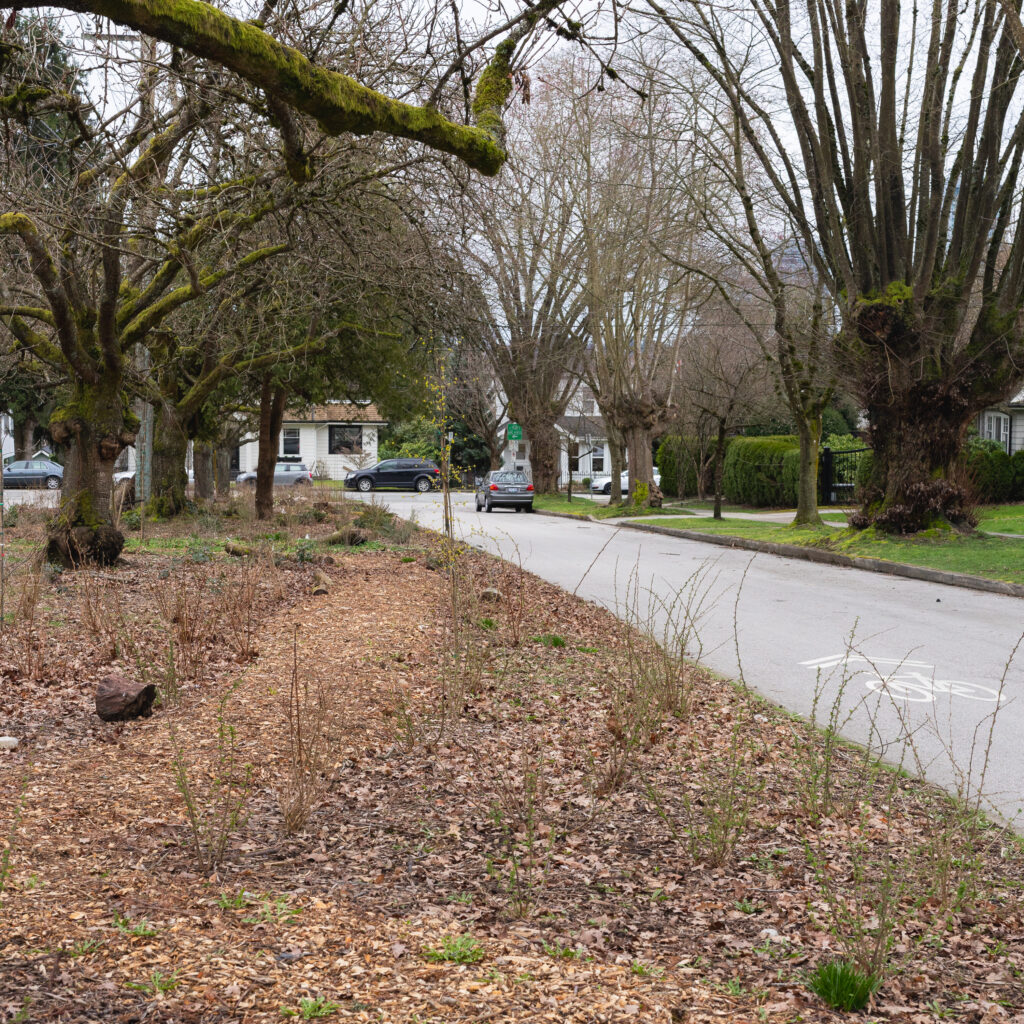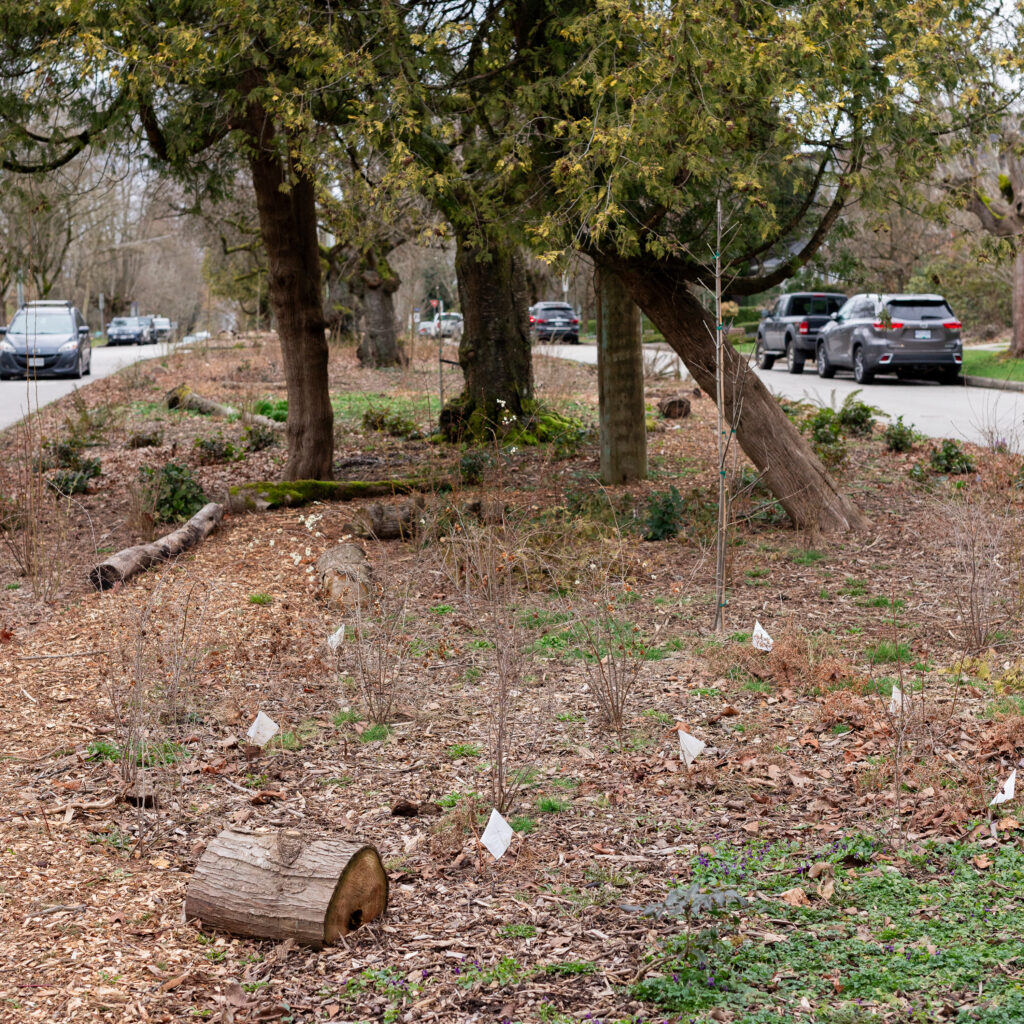Would landscaping made up of mulch, small logs, and ferns ever inspire comparisons to the destruction in Gaza? In New Westminster it did, and all it took was the removal of a few square meters of grass on public property to start a turf war.

Why have a boulevard if you choose to destroy it? Gaza looks more interesting to explore.
—Gord, correspondence to city council on Wednesday, March 5th
The City of New Westminster council approved a Biodiversity and Natural Areas Strategy in 2022 which included action items such as planting ground vegetation, placing ground cover objects (logs), and installing green infrastructure to manage stormwater. Some of these actions were implemented on a 6-metre wide boulevard on 2nd Street in the Queens Park neighbourhood. Mulch and leaves were spread, logs were placed, and plants were planted. Yet within days of this happening some nearby residents voiced their extreme displeasure to city councillors with quotes like the one above. There was much disdain for doing something this distasteful in their “unique” neighbourhood.

It’s that ridiculous quote from correspondence to council that indicates how averse to change some people are, and how residents’ feelings of entitlement to public property is a cause for concern when it comes to community improvement. Some city councillors are happily leaning into this aversion to change, although thankfully without the comparison to war zones.
This was about grass, and its removal. But it wasn’t, really. This was another example of thoughtful community planning and policy facing pushback from a small number of people with the time and energy to crusade against change.
These plans and policies weren’t created in secret moss-covered meeting rooms by scheming biologists, rather they were publicly endorsed by council, with opportunities for public comment. They were the product of thorough work by city staff, where residents could give their input through community consultation.
Government agencies often engage residents when developing plans like these to avoid the very scenario we are now seeing: every individual project becoming controversial due to pushback from a tiny vocal minority. Opposition like this whittles down projects, takes up precious staff time, dominates civil discourse, and occasionally kills good projects despite broad support among the general population.
Another example of this issue arose at the same council meeting where the boulevard debate took place. A pair of residents were insistent in their support for rain gardens being installed in their neighborhood. What was their issue, then? The rain gardens in question didn’t belong in front of their house.
This may be a predictable example of the age-old story of NIMBY-ism, but it is frustrating and counterproductive nonetheless. Collective acceptance of good projects is necessary for a city to improve. Punting a given project to someone else is counterproductive, but unfortunately this behavior is the norm across governments in Canada.
How do we avoid issues like this?
The grass “debate” is a microcosm of the process-hell that nearly every public project has to go through in BC, from building homes to wastewater treatment plants. By building consultation into every possible stage of a project, those with the energy, ability, and free time to exercise their influence (think older, richer, whiter) are imbued with undue power, and in some cases—a de facto veto over projects.
To counter this, government agencies must be more intentional and thoughtful about how and when they apply public consultation as a tool. Take street-level changes for example. Instead of consulting about every aspect of a theoretical design, agencies could deploy a “quick-build” prototype so the public can see it in action. Not only does this highlight the benefits of the solution to users, it also qualms some of the “imaginary” problems some residents can dream up.
This approach can also be applied to entire metro areas. Seville is an illustrative example of this in action. The Spanish city quickly built out a comprehensive cycling network in two years, running public consultation process in parallel that allowed them to change designs as they built.
Thankfully, there is growing awareness that our governments often face a consultation-afflicted “analysis paralysis”. A possible remedy to one corner of this issue was recently introduced at the provincial level to ban unhelpful and often antagonistic public hearings for individual housing developments that are already compliant with local Official Community Plans (OCPs)—the overarching documents in every BC municipality that governs land use.
This strategy front-loads the engagement process with thoughtful and inclusive engagement, which then allows developing the plan based on that consultation. With the consultation done citywide for the OCP, public hearings are disallowed for residential developments. This means badly-needed new housing projects can clear municipal approval without entirely compromising public input. Rather than being an attack on public freedoms as some claim, this reform prevents “over-engagement” on individual issues that have already had extensive public consultation.
This strategy is something that could be effectively utilized in other aspects of community planning too. Broader engagement on biodiversity and nature plans, or on sewer separation and stormwater management plans should be conducted before the implementation gets underway. If the plan was adopted with community engagement, then implement it. Governments can’t keep letting agreed-upon-plans be watered down so that they lack effectiveness, balloon in cost, and take longer than planned: all things that further stoke hesitance to change and public skepticism.


Leave a Reply